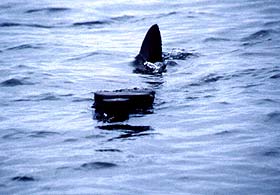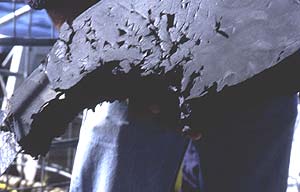
|
|
|
|
|
|
Shark Info (06-01-2000) |
Author |
|
Intro: |
Mexico: Poachers slaughter thousands of sharks in underwater park |
Shark Info |
Main article: |
Mexico: Drift net poachers slaughter thousands of sharks in unique underwater park |
Shark Info |
Article 1: |
Dr. A. J. Godknecht |
|
Article 2: |
Dr. E. K. Ritter |
|
Article 3: |
Shark Info |
|
Fact Sheet: |
Dr. E. K. Ritter |
|
Investigating surfboard accidentsDuring my work in South Africa last February, I was asked to help in the investigation of a surfboard accident with a great white shark (Carcharodon carcharias). An analysis showed that the shark had attacked and grabbed the surfer from behind and then returned at least twice. Unfortunately in this case the surfer died. Based on available details of the incident, I concluded that the surfer could not have been bitten by accident but that other factors must have played a role. Part of my work as advisor for the "Global Shark Attack File (GSAF)" of the Shark Research Institute in Princeton, New Jersey, USA (also see the report in Shark Info 1/99), includes investigating and testing possible causes for such accidents in addition to examining and analyzing the sequence of events in such cases. When I returned to South Africa in May to work on another project I also used the opportunity to test some initial theories on the cause of this latest fatal event, the type of accident which is usually explained by saying that the shark mistook the surfboard for a seal. Important ConsiderationsOur tests were intended to consciously provoke attacks by white sharks to enable an analysis of the factors which triggered the above incident. Past accident statistics show that white sharks usually bite surfers who sit or rest quietly on their board, i.e. who do not actively move away. If one accepts the hypothesis that sharks mistake surfers for seals, then sharks will find a dummy resting motionless in the water interesting and sooner or later will grab or attack it. In order to increase the sharks' curiosity we selected a dummy resembling a seal rather than a surfboard, considering that seals are the white shark's preferred prey. The dummy was black (not colored as most surfboards are) and was made of multilayered rubber. As an alternative to the immobile dummy, a second experiment was made in which we pulled the dummy at a constant speed of 5 knots (9.26 km) per hour at a distance of 15 m behind the boat.
Initial ResultsMotionless Dummy During two weeks of continuous experimentation we managed to attract up to 10 white sharks per day to the motionless dummy in the water. However, only in rare cases did they bite the dummy, and then only very reluctantly and never with the force and speed observed when they pursued seals. The sharks always approached the dummy from behind - swimming directly on the surface - or vertically from below. At no time did the sharks accelerate their speed as they normally do with real prey. At high speeds, sharks can even jump completely out of the water. It thus appears that sharks do not mistake this dummy for a seal, otherwise they would have directly attacked it. Only the silhouette appears to have aroused their curiosity because it resembled the familiar search image of a seal, an image which predators have to help them concentrate on a target and react very quickly.
Moving Dummy Here the situation took a different turn, for as we pulled the dummy behind the boat in accordance with the second test approach we registered up to five attacks per hour. Most sharks jumped out of the water when attacking. In some instances the animals, which measured up to 5 m in length, were even seen completely out of the water, indicating extremely high acceleration and attack speed. This experiment was also interesting from another point of view since it showed that in most cases biting was only a means of holding onto the prey. Only once was the dummy bitten in two. Analysis of the videos showed that the sharks would drop the dummy as they fell back into the water. It was also astonishing to note that the sharks do not always approach from behind or below, as expected, but often also from the front, directly into the dummy's path. Depending on the angle of approach the sharks jumped fairly horizontally or vertically out of the water. At steep jump angles, they would rotate once in the air, but not when swimming horizontal paths. Similar behavior has also been observed when they attack seals, e.g. on Dyer Island (South Africa). Attacks on a moving dummy are perhaps explainable by the white shark's hunting behavior and the behavior of the seals. Seals are very agile and are thus not an easy prey, in addition they can defend themselves astonishingly well by biting. Furthermore, they often swim in the vicinity of cliffs and rocks and only seldom in open water, preferring regions which serve as natural protection from sharks. Even such skilled predators as the great white shark does not have access to abundant food supplies since nourishment is usually fairly scarce in the ocean. A seal swimming in open waters is thus considered an easy meal and provokes a quick reaction or attack. An older assumption, known as the exsanguination or bleeding theory, offers another possible explanation why sharks have rarely bitten the dummy (only in one instance). According to this theory white sharks attack to wound the prey, then retreat to prevent a fight and from wounding themselves, waiting until the prey is weakened by the bleeding wounds before reattacking at no risk to themselves. It is thus possible that the moving dummy comes very close to their search image of "here is a freely swimming seal", thus triggering a fast reaction. Another possible reason for the attacks could be the low frequency vibrations stemming from a slowly operating boat motor. Sharks presumably react to such vibrations because they may resemble those stemming from wounded animals. However, additional investigations must be made to verify this. Another reason why the shark can be provoked to an untypical quick attack may be the search image "here is a wounded, freely swimming seal". In our experiments the sharks appear to have mistaken the dummy for a seal (it was, after all, a dummy seal), since the stimulus threshold eliciting an attack is very low in such a tempting situation. Still, a white shark can in such an instance clearly distinguish between a moving surfboard and a seal (or other appropriate dummy), otherwise attacks on moving surfers would be more frequent from a statistical point of view. Still, it is too early to draw definite conclusions from these tests. In the Fall we will begin systematically changing certain parameters of our experiments, including the form, material and smell of the dummy as well as speed in order to determine which stimuli elicit a response from the sharks and finally which factors really lead to their attacking and biting surfers. At the moment, one thing is certain: When it comes to a motionless dummy in the water, great white sharks can differentiate quite well between seals and surfboards and will only approach the surfboards with great caution and curiosity. * Dr. Erich K. Ritter is a shark biologist and adjunct assistant professor at Hofstra University, New York (USA) May be published only by indicating the source: Shark Info / Dr. E. K. Ritter |
|
|
|
|
|
|||||

